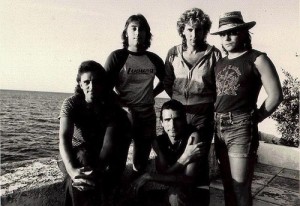Editor’s note: In this installment of EhOR, Jay Kumar examines the long career of Saga, a band that found success straddling the worlds of prog rock, hard rock and pop.
In the mid-’70s, prog rock found favor with mass audiences thanks to the likes of Yes, Genesis and King Crimson. Soon, newer bands emerged, melding proggy elements with poppier fare. In the Toronto suburbs, as bands like Rush and Triumph were having success with their take on prog, a band called Pockets decided to change its name to Saga and released its self-titled debut in 1978. Formed by lead singer Michael Sadler, guitarist Ian Chrichton and bassist Jim Chrichton, the band was rounded out by keyboardist Peter Rochon and drummer Steve Negus. Nearly 40 years later, Saga is still at it, although the band is primarily remembered in the U.S. for its brief period of AOR prominence in the early 1980s.
Strangely enough, Saga didn’t make much of an impression in their homeland at first. Their first album, however, made an immediate splash in both Germany, where it sold 30,000 copies as an import, and Puerto Rico, where a stereo store used a snippet of Saga’s ”Humble Stance” in its radio ads. Canadian success followed with 1979’s Images in Twilight album, which saw the band score a minor FM hit with ”It’s Time.” The following year’s release, Silent Knight, scored well on the Canadian charts, hitting #42 on the strength of the singles ”Don’t Be Late” and ”Careful Where You Step.” The band was making inroads by touring and opening for the likes of Rush.
While the first three records featured sci-fi themed covers and the kind of tight musicianship (highlighted by Ian Chrichton’s precise guitar work) that endeared them to prog fans, it wasn’t until 1981’s Worlds Apart that the band broke through to a wider audience: namely, the U.S. Helmed by uber-’80s producer Rupert Hine, the album saw ”On the Loose” hit #26 on the Billboard singles chart and ”Wind Him Up” reached #64; the album itself hit #29. The newly launched MTV played the band’s videos with regularity, boosting Saga’s profile. The album ended up going gold in the U.S. while back at home, Saga won the Juno (the Canuck equivalent of the Grammys) for Most Promising Group of the Year. Alas, Worlds Apart would be the band’s commercial peak Stateside.
https://www.youtube.com/watch?v=A51gkF7eu_A
The band would follow up with 1983’s Heads or Tales, again produced by Hine. Lead singles ”The Flyer” and ”Catwalk” were minor FM hits in the U.S.; ”The Flyer” reached #79 on the Billboard singles chart in November 1983, making it Saga’s last U.S. hit. ”The Sound of Strangers” was also a hit in Canada. Heads or Tales hit #92 on the U.S. album chart and #17 in Canada, but interestingly enough, it was a top 5 release in Germany, Norway, Sweden and Switzerland.
https://www.youtube.com/watch?v=_Owcq5tYSkg
Saga continued pushing in a pop-oriented direction, placing less emphasis on the prog sound of the earlier albums. For the sixth album, 1985’s Behaviour, the band worked with a different producer (Peter Walsh) and embraced more of the pop flourishes of the era: Electronic drums, more sweeping synths and fewer keyboard solos and a general romantic vibe that was more late-era Roxy Music than Rush. ”What Do I Know?” was a minor hit, charting in Canada and popping up on MTV and FM stations in the U.S. The album actually sold marginally better than its predecessor in the U.S., reaching #87 and #39 in Canada, while still hitting the top 10 in several European countries.
In 1986, band tensions escalated and drummer Steve Negus and keyboardist Jim Gilmour were sent packing. As a result, the next Saga album, Wildest Dreams, featured Sadler and the Chrichton brothers backed up by drummer Curt Cress and a phalanx of electronics. The band had signed to Atlantic and was preparing a big push for the pop-oriented record, but the album completely stiffed in the U.S., failing to chart and only hitting #77 in Canada. It fared a better in Europe, as was the pattern for Saga. ”Only Time Will Tell” got some MTV airplay, but didn’t amount to much, hitting #93 in Canada.
It was back to the proverbial drawing board for the foursome with 1989’s The Beginner’s Guide to Throwing Shapes, as Saga returned to the prog-first, pop-later approach of its earlier albums. However, it appeared the band’s time had passed in North America. Dropped by Atlantic and ignored by radio, the album failed to chart anywhere, which may have also had to do with changing tides in the music industry as the 1990s began. But despite these setbacks, Saga continued to release albums and tour consistently. Since 1993, the band has released 14 studio albums, with nearly all of them charting in Germany and some in Sweden and Switzerland.
https://www.youtube.com/watch?v=bDZ5X1cZV-Y
There have been some lineup changes along the way. Original members Gilmour and Negus returned in 1993. Sadler left the band in 2007, and the following year after auditioning new singers via YouTube, the band chose Rob Moratti as its new vocalist. Saga released one album with Moratti before Sadler returned to the fold in 2011. Currently, the band consists of four of the five core members (Sadler, the Chrichton brothers and Gilmour) along with drummer Mike Thorne. In 2014, Saga released its 21st studio album, Sagacity.
Although tours have primarily focused on Europe in recent, Saga keeps plugging away. But for a pocket of older U.S. prog fans, there will always be those early albums to go back to, as well as a vast collection of later recordings to check out.






Comments